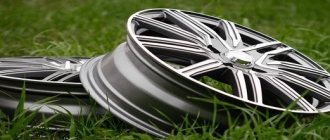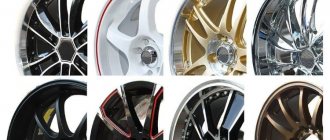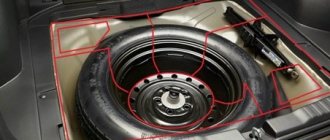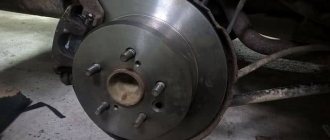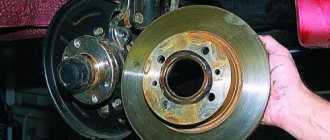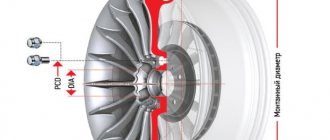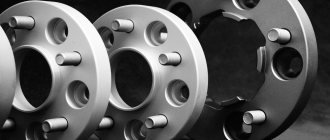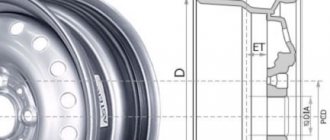Today, most car owners focus on the appearance and diameter of the rims, but do not realize that there are other parameters, the most important of which is offset, also known as ET.
Overhang is the distance from the middle of the disk to the plane of its alignment with the hub. This parameter is measured in millimeters, and on disks it is indicated by the symbols ET. You can find out the departure using a simple formula: ET=XY/2, where:
- ET – offset (internal or protruding),
- X – distance between the planes of the disk,
- Y – disk width.
BBS disk failure
Regardless of the offset, when choosing disks it is necessary to take into account other meanings, for example, abbreviations such as:
- B – width of the disc between the rim flanges,
- J – design features (a simple car enthusiast does not need to know them),
- X – (indicates that the rim is not removable),
- Dia (other spellings are possible) – central hole.
Varieties of departure
There are three types of offset, each of which is assigned a corresponding marking (painted on the inside of the disk):
- ET20 (zero offset) - when the surface with which the disc is pressed against the hub coincides with the central plane of the wheel,
- ET0 (positive offset) – the vertically located axis of the disk is distant from the point of contact with the hub by a certain distance,
- ET-20 (negative offset) - when the surface with which the disc is attached to the hub is carried beyond its vertical axis.
Today the most common disc offset is ET0. Negative and zero offsets, on the contrary, are rare. Wheels with such an offset are installed on specially prepared cars, for example, for racing, both off-road and on tracks.
The offset parameters are regulated by vehicle manufacturers, and, as they say, there should not be any deviations (even a few mm). Otherwise, the operating conditions of all suspension units change, which under critical load conditions can lead to tragedy.
Types of departures
What depends on departure?
The width of the wheelbase, as well as the symmetry of the wheels, depends on it.
Any offset errors have a detrimental effect on the suspension elements and contribute to rapid wear of the working mechanisms of the vehicle. Each car brand has its own Et value, which is calculated using a special formula that eliminates possible errors. ET=a-b/2 , where a is the distance between the inner part and the contact plane, B is an indicator of the width of the disk. ET – these letters indicate the offset on the marking. The numbers following this designation determine the offset in millimeters.
For example, ET45 means positive offset, 0 means zero, and 15 means negative. Near-zero and negative values are typical for wheels of SUVs and sports cars. In other words, for vehicles with a wide gauge.
Manufacturers' recommendations
There is no consensus among automakers regarding the permissible deviation from the offset and some insist on full compliance with their recommendations, others allow the deviation within +/– 5 mm, and still others independently indicate several offset options. What is the reason for such a big difference in opinions?
Reduced wheel offset
The fact is that in a competitive environment, automakers are forced to save their resources, so the loads on all machine elements are calculated with extreme accuracy. So even a slight discrepancy with the declared characteristics can lead to damage to the part.
By the way, experts have calculated that if you reduce the disc offset by 50 mm, this will lead to an increase in the load on the suspension by 1.5 times more than normal. This also explains the difference in reach for cars of the same model, but with different modifications of power plants.
What does the PCD parameter mean on rims?
Almost every car enthusiast, faced with the need to purchase new rims, is faced with the same question: PCD on rims - what is it. To give the most complete answer, it is necessary to completely decipher the inscription on the back of the wheel, which characterizes its dimension using a specific example. If we take the parameters of an average wheel 6.0J x 16 ET42 5x108 d66.1, where each symbol indicates the following indicators:
Wheel store-warehouse
- 6 is a characteristic of the width of the rim of the product at its widest part, expressed in inches. This size for passenger cars ranges from 4.0 to 12.0 inches in increments of 0.5 inches.
- J – the shape of the bead edge for reliable fixation of the tire, which are also designated as JJ, K, JK, B, P or D.
- 16 – the radius value, that is, the diameter of the wheel rim, expressed in inches. Many car enthusiasts incorrectly call this parameter radius, but this is incorrect. The wheel diameter in classic versions ranges from 12 to 24 inches.
- ET42 is the disc offset indicator in millimeters, the projected distance from the point of attachment of the wheel to the hub to the inner mating plane of the wheel, which ranges from -25 to +50 mm, that is, it can be negative, and the product will protrude beyond the transverse dimensions auto.
- 5x108 is an indicator of the bolt pattern, that is, a value indicating the number of studs on which the disc is attached to the suspension elements (4, 5 or 6 for passenger cars). The second number – 108 – is the length of each fastener in millimeters, found in the range from 90 mm to 150 mm, depending on the weight of the car and its class.
- At the end of the product labeling there is an answer to the question of what PCD is in disk parameters and how this characteristic can be determined. The last indicator - d66.1 - is precisely the PCD value, or Pitch Circle Diameter, which in translation means the diameter of the circle along which the holes for the studs are located at an equal distance from each other. The larger this parameter, the greater the bending moment the wheel can absorb. Accordingly, the PCD, also called drilling, ranges from 50 mm to 150 mm depending on the wheelbase size and vehicle weight.
Wheel rim size Important! If any of the indicators (width, radius or offset) for each car can vary within insignificant limits, then the PCD value should remain constant, since the design of the hub is unchanged, and in practice, almost all automobile concerns have long established a standard in accordance with one or another car class. Thus, on compact cars with an engine capacity of up to 1.6 liters, the drilling pattern does not exceed 70 mm, and the bolt pattern rarely goes beyond 4x100; for crossovers, this figure can reach 100 mm and 5x120, respectively, and as for large SUVs, it increases sharply to 140-150 mm, and bolt pattern - up to 6x150.
How to measure offset
You can measure the offset yourself; for this you will need the simplest tools, such as: a rack, a tape measure, a jack, a wheel wrench, and tackles.
- First you need to jack up the car and put it on the handbrake.
- Then remove the wheel from the car and measure the rear offset.
- To do this, the wheel should be placed on the ground with the side opposite to the hub.
- Next, you need to place a rail on the inside of the disc, with its edges lying on the sides of the rim.
- Afterwards, the distance is measured from the surface with which the disc is pressed against the hub to the lower edge of the rack.
- Then the frontal setback is measured - when the edges of the rack (lie on the outer sides of the rim).
- To do this, turn the wheel over to the other side and measure the distance from the mating plane of the disk to the bottom edge of the rack.
Reach calculations (in mm) are carried out using the following formula:
ET = (A+B)/2 – B, where A is the rear, and B is the front, indents.
| Tire diameter | Wheel Rim Width (inches) | Optimal protrusion (mm) | Permitted deviations |
| R16 | 6.5 | 48 | From 40 to 55 |
| R16 | 7 | 45 | From 40 to 55 |
| R16 | 7.5 | 50 | From 40 to 55 |
| R17 | 7 | 52 | From 40 to 55 |
| R17 | 7.5 | 50 | From 40 to 55 |
| R17 | 8 | 48 | From 40 to 52 |
| R18 | 7 | 48 | From 40 to 55 |
| R18 | 7.5 | 48 | From 40 to 55 |
| R18 | 8 | 50 | From 40 to 52 |
| R19 | 7.5 | 48 | From 40 to 55 |
| R19 | 8 | 50 | From 40 to 52 |
| R20 | 7.5 | 48 | 45 |
Based on the table presented, it can be understood that the answer to the question will depend on the size of the wheel rim offset - will the measured wheel fit on the car?
see also
Comments 87
5+ for effort and mathematics! Well done!
girl, you are a genius)) I kept thinking about how to measure it, I started reading, I finished reading to the board and it dawned on me how I hadn’t thought of it before))))) Thanks!
what if the discs are negative?
worthy! Thanks it helped :)
Not every guy behind the wheel knows this, but the girl is smart! ))
I googled it and sent it here))), everything seems clear. So we measure size A, this is the back, B is the front. If it works, then the departure is negative, right? What is HAMP? ))
the lady was too clever) if I’m not mistaken, it’s easier to do this: let’s say the disk width is 8.5 inches. 1 inch = 25.4 mm, therefore the width of the disk is 8.5 * 25.4 = 215.9 mm. to find out where the center is, we simply divide it in half: we get 108mm. Well, as the girl suggested - we turn the disk face down, put the rail on the rim of the disk. Using a tape measure, measure the distance from the mating surface of the disk to the hub to the bottom edge of the bar. On my summer ones this distance is 154mm. And then we find the modulus of the difference between the last two values: |108-154|=46mm. - here is the departure of my summer skating rinks)
the lady was too clever) if I’m not mistaken, it’s easier to do this: let’s say the disk width is 8.5 inches. 1 inch = 25.4 mm, therefore the width of the disk is 8.5 * 25.4 = 215.9 mm. to find out where the center is, we simply divide it in half: we get 108mm. Well, as the girl suggested - we turn the disk face down, put the rail on the rim of the disk. Using a tape measure, measure the distance from the mating surface of the disk to the hub to the bottom edge of the bar. On my summer ones this distance is 154mm. And then we find the modulus of the difference between the last two values: |108-154|=46mm. - here is the departure of my summer skating rinks)
One problem: the width of the rim is NOT the distance between the flanges and it will no longer be possible to measure it on a rim, for example, with a tire. How do you propose to measure the distance from the contact plane to the border of the disk width? Shall we make a measuring angle? Well, there is no vertical line to which you can attach a tape measure. So the girl is great, smart and in 2 actions, without showing off.
Consequences of changing disk offset
A change in reach inevitably shifts the steering axis, which entails deviations in the steering wheel turn parameters provided by the factory.
Long reach wheel
Reducing or increasing the reach affects not only the car's handling. This affects the wear of bearings and rubber, and also forces the suspension to work in extreme mode, which affects driving safety in general and is similar to a lottery with low chances of winning. In addition, it is important to know that:
- the diameter of the hole for the hub on the “stamping” must match the value recommended by the car manufacturer (+– 0.1 mm),
- the central hole for the hub on cast or forged disks is determined by adapter rings,
- Stock discs usually do not require the installation of centering rings, and are manufactured immediately with the hole diameter required for the hub.
Even if a disc with an offset not specified by the car manufacturer “sits” on the hub without any problems, this does not mean at all that it is suitable for safe driving, because the offset of a wheel rim affects each car differently.
If the car mainly moves on asphalt, then the negative impact on the suspension will be minimal. However, if you put wheels with a “non-original” offset on a jeep, then first of all, and this will happen quite quickly, the wheel bearings, steering ends and ball joints will fail, after which you will still have to return to the standard wheels.
There is also such a thing as a rolling shoulder. If you drive one wheel onto the side of the road with a normal offset, the car will continue to move further, since the force acting on the wheel does not turn it - the wheel's turning axis is located approximately in the center of the bearing. If the offset is greater than recommended, then the wheel will pull to the side of the road, and if it is less, then to the road.
How to determine the permissible ET deviation for a disk
As a rule, each automaker dictates its own permissible deviations for disc offset, and they depend only on the design of the frame, suspension, calipers, wheel arches and other elements of the vehicle. This means that for each car caliper there is a certain indicator of compatibility of various sizes, expressed in the range from minimum to maximum ET in millimeters. So, below are the permissible deviation indicators for the 35 most popular car models in Russia:
Conclusion
The persistent attempts of numerous car enthusiasts to install wheels with an offset that does not meet the manufacturer’s parameters are mainly due to either a lack of awareness about the consequences of this, or a desire for tuning.
Often, car owners deviate from the factory offset parameter in order to improve the performance characteristics of the car. In addition, the extended wheelbase gives the car an aggressive, sporty look.
Some tips for choosing disks:
- the appearance of the disk should not dominate its technical characteristics,
- You should not unconditionally trust sellers,
- It is important to pay attention to the disc labeling.
When purchasing rims, you should not limit yourself to just a visual check. It should be remembered that driving safety and even human life depend on this choice!
Drivers' needs
What is the need for changing the standard disc offset parameter? This is largely due to the banal need of car owners. This act is dictated by a disdainful attitude towards safety, but there is a great desire to improve one’s status through visual improvement of the car. Installation of fashionable wheels, which, although they do not correspond to the standard offset, look very cool and cause delight from others.
In addition, many people intend to expand the wheelbase of the car in this way, which gives it a more sporty look. The situation is made worse by some sellers. They may know what ET disk offset is, but to please themselves they prefer not to strictly follow the manufacturers' recommendations. As a result, they persuade car enthusiasts to make a purchase, but whether it fully matches the car or not is no longer important.
View gallery
The main thing is that the disc will be purchased. Usually, when installing disks with an inappropriate offset, no problems arise. However, this is not yet a reason to think that the operation of the car is completely safe. And some kind of trouble can still happen.
If you really want it
But what if you really need or really want to change the appearance of your car using wheels of non-standard geometry? For such cases, there is a reasonable alternative - wheel spacers. This engineering solution allows you to reduce the offset (increase the distance between the hub and the disk), and thus move the wheels outward. In addition, spacers make it possible to install even disks in which the number or location of mounting holes does not coincide with the fastenings on the hub itself.
There are two types of wheel spacers on sale, differing in thickness and functionality.
The first type of spacers are ordinary metal washers 6-12 mm thick with through holes. To install them, you will need to select hub bolts that are longer than the standard ones by the thickness of the spacer.
The second type is an already improved version with technological holes both for the hub bolts and for the bolts for separate fastening of the spacer to the disk in case of mismatch of fastenings. Their thickness can be from 12 to 20 mm.
Wheel spacers can be used for:
- adjusting the offset value to the recommended values;
- mounting the disk on the hub if the mounting holes do not match;
- changes in the offset value relative to the values recommended by the manufacturer.
Diameter
15 – (D) — Disc diameter in inches. Please note that the rim diameter is not the outer diameter of the rim from edge to edge, and, as with width, it is the diameter of the rim “flange” on which the tire bead rests.
Therefore, if you want to measure the outer diameter of a car rim with a tape measure, you must take into account that in fact its actual value is slightly smaller. And to convert the diameter of the disk from centimeters to inches, you need to divide the resulting value by 2.54.
Those. if you measured 40.6 cm, then:
Disc diameter = 40.6 / 2.54 = 16 inches
H2 - Design code and number of humps (variations of humps: H - simple hump, H2 - double, FH - flat (Flat Hump), AH - asymmetric (Asymmetric Hump), CH - combined (Combi Hump)) Humps - small annular protrusions serve to keep the tubeless tire from jumping off the rim. This parameter is not taken into account when selecting disks.
Disc width
6.5 – (B) — Wheel width in inches (sometimes this value is marked in the form Width is measured not along the outer sides of the wheel, from edge to edge, but along the so-called “wheel shelf” on which the sidewalls of the tire rest. Width tires and rims must strictly correspond to each other so that the tires, after installation on the rims, have the optimal shape specified by the manufacturer.You can calculate the required rim width using a tire calculator.
J - Shape of the side flange of the rim (can be JJ, JK, K or L). When selecting car wheels, this parameter is not taken into account, and you don’t have to pay much attention to it.
MAX LOAD
There is one more additional parameter that has nothing to do with the size of the disk, but it is important for the correct selection of the disk. This parameter is called MAX LOAD - maximum load on the disk. For passenger cars, rims are usually made with a safety margin, but if rims for a passenger car are placed on a jeep or minibus, they may not withstand the load and become deformed if they fall into even a minor hole. Therefore, when choosing wheels for a jeep or other heavy vehicle, be sure to pay attention to the recommended maximum load on the disk. MAX LOAD is measured in pounds or kilograms. To convert pounds to kilograms, you need to divide them by a factor of 2.2
.
For example, if the specified load is 2000
lbs (2000LB) then:
MAX LOAD = 2000LB = 2000 / 2.2 = 908 kg
more detailed information about which disk parameters are suitable for your car on the pages “How to find out disk parameters?” or talk to our specialists.
For additional information on disc labeling, you can contact a specialist by calling:
Attention! All contents of this site are protected by intellectual property legislation (Rospatent, registration certificate No. 2006612529). Installing a hyperlink to site materials is not considered a violation of rights and does not require approval. Legal support of the site - legal..
Reading time: 6 minutes
Quite often, car owners install new rims, and many do this not because of breakdown or wear of previous products, but in order to improve the appearance of their “iron horse”. So, when purchasing a new wheel, car enthusiasts always look not at its drilling, that is, the diameter of the mounting hole on the hub, the bolt pattern, or the number and length of the studs on which this wheel is installed, but few people pay attention to the offset of the product (ET), and this is very important indicator for normal operation of a wheel on a specific car model.
What is ET on rims? This question is asked by many car enthusiasts, especially those who purchased their cars relatively recently and, until today, have never encountered the problem of replacing wheels on them.
Geometric characteristics of the wheel rim
Will it be a problem to install a disk whose offset does not correspond to the recommended one?
Yes. There are many reasons why the use of incorrectly selected products is not acceptable. First of all, this concerns the correct functioning of the suspension. By installing beautiful, but incorrectly selected wheels for your car, you risk running into problems.
It is known that all functional components of a vehicle have their own service life and are designed for a certain effort. By using a disc whose offset does not quite suit the design of the car, you thereby upset this balance, which leads to premature wear of suspension parts. It’s good if it’s just a reduction in the service life of some component - in this case it can simply be replaced. But if a breakdown occurs while driving, then sad consequences cannot be avoided.
Quite often, disc sellers neglect accuracy in relation to the offset value. Thus, they try to offer you a non-specific model, which may very likely not meet your aesthetic requirements, but show the maximum of products in order to increase the likelihood of purchase.
